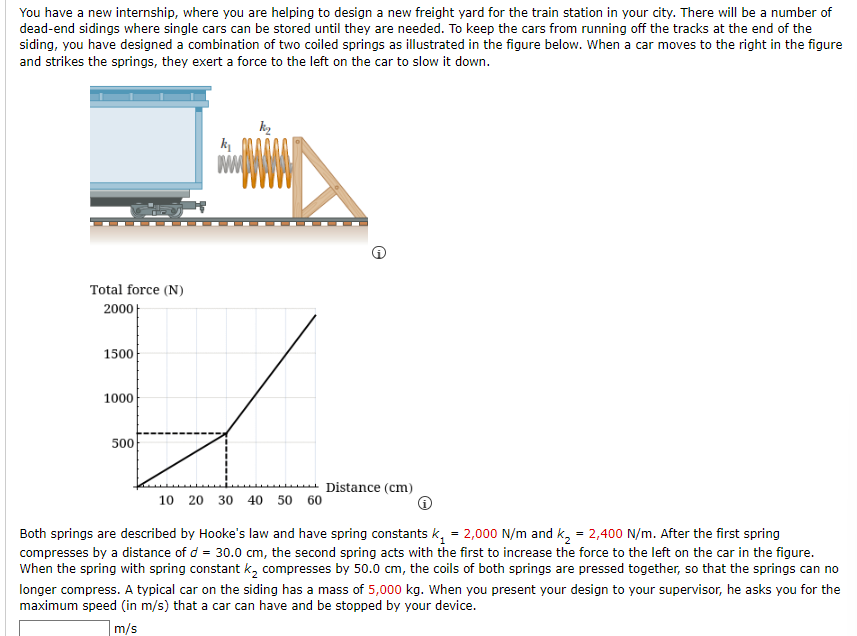You have a new internship, where you are helping to design a new freight yard for the train station in your city. There will be a number of dead-end sidings where single cars can be stored until they are needed. To keep the cars from running off the tracks at the end of the siding, you have designed a combination of two coiled springs as illustrated in the figure below. When a car moves to the right in the figure and strikes the springs, they exert a force to the left on the car to slow it down. M Total force (N) 2000 1500 1000 500 Distance (cm) 10 20 30 40 50 60 Both springs are described by Hooke's law and have spring constants k₁ = 2,000 N/m and k₂ = 2,400 N/m. After the first spring compresses by a distance of d = 30.0 cm, the second spring acts with the first to increase the force to the left on the car in the figure. When the spring with spring constant k₂ compresses by 50.0 cm, the coils of both springs are pressed together, so that the springs can no longer compress. A typical car on the siding has a mass of 5,000 kg. When you present your design to your supervisor, he asks you for the maximum speed (in m/s) that a car can have and be stopped by your device. m/s
Plane Trusses
It is defined as, two or more elements like beams or any two or more force members, which when assembled together, behaves like a complete structure or as a single structure. They generally consist of two force member which means any component structure where the force is applied only at two points. The point of contact of joints of truss are known as nodes. They are generally made up of triangular patterns. Nodes are the points where all the external forces and the reactionary forces due to them act and shows whether the force is tensile or compressive. There are various characteristics of trusses and are characterized as Simple truss, planar truss or the Space Frame truss.
Equilibrium Equations
If a body is said to be at rest or moving with a uniform velocity, the body is in equilibrium condition. This means that all the forces are balanced in the body. It can be understood with the help of Newton's first law of motion which states that the resultant force on a system is null, where the system remains to be at rest or moves at uniform motion. It is when the rate of the forward reaction is equal to the rate of the backward reaction.
Force Systems
When a body comes in interaction with other bodies, they exert various forces on each other. Any system is under the influence of some kind of force. For example, laptop kept on table exerts force on the table and table exerts equal force on it, hence the system is in balance or equilibrium. When two or more materials interact then more than one force act at a time, hence it is called as force systems.

Trending now
This is a popular solution!
Step by step
Solved in 3 steps with 2 images









